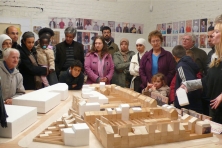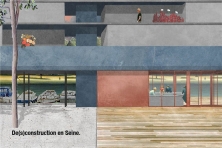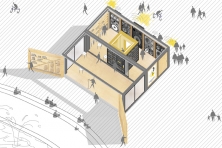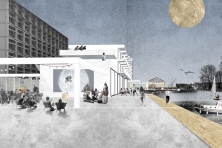Extractions, from source to resources
Auby (FR) - Winner
TEAM DATA
Team Representative: Amandine Martin (FR) – architect; Associates: Céline Tutcu (FR), Faustine Pauchet (FR), Justine Labérenne (FR) – architects
atelier-ine
52 rue de Douai, 59000 Lille (FR)
+33 611745268 - ine.architecture@gmail.com
See the complete listing of portraits here
See the site here

A. Martin, C. Tutcu, F. Pauchet, J. Labérenne
VIDEO (by the team)
INTERVIEW
1. How did you form the team for the competition?
We had the opportunity to work together on several projects during our studies at the architecture school of Lille. That allowed us to start to implement new methods together as well as some shared work topics. This is why, taking advantage of this complicity, we wanted after our studies to continue to share our thinkings about themes of various scale and disciplines.
2. How do you define the main issue of your project, and how did you answer on this session main topic: the place of productive activities within the city?
Our problematic answers the question of the competition by contextualizing it to the challenges of the city of Auby. How can housing become productive? It seemed to us necessary to think about the place of productive activities in the city through housing. This Northern city of France, close to Lille, must avoid an urban growth that would lead it to become a bedroom community. The unemployment rate is high; so, to avoid widening a social division between the present and future inhabitants, the project must take place over a long period of time and allow to reveal the living energies underlying Auby. This is why we decided to propose an urban project which would be fed by a social and economic project with the association Zero Unemployment Territory ( Territoire Zéro Chômage ). We propose a process that permit to the Auby inhabitants to be involved in the economic development of the municipality and the enhancement of their patrimony. So we question the place of productive activities in the city through housing. Firstly by using existing housing to create new workplaces, and secondly by proposing new types of housing which allow production times and which can respond to the expectations or the futur inhabitants. For this we propose a process project rather than a fixed urban project. Our approach is incremental, we take the side to create an open method which will be able to adapt to the concerned actors and to the technical diagnoses of the existing sites.
3. How did this issue and the questions raised by the site mutation meet?
Given the context of the city of Auby set out above, we have made this social and economic issue our lever for tackling the urban problem of the project site. Indeed, by offering to work with the TZCLD association, it seemed logical to take advantage of this new dynamic to start an urban project. Thus, our scenario is experienced in two stages.
As a first step, the site proposed by Europan contains a block of existing houses which are destined to be destroyed in order to build housing there. Driven by a desire for frugality, our intention is rather to seize this building, "the block of the tip" and to reveal it as a common heritage, a resource to be rehabilitated to make it a pilot city of TZCLD. The building is diagnosed, house by house, in order to define its programmatic potential to accommodate the needs of future employees of TZCLD (for example a resourcery, artist workshops, etc.). The existing housing then becomes productive and makes it possible to restore dignity to the inhabitants by offering them places of work and exchange which enhance the built heritage. In a second step, on the Zac du Château d'eau, which will have been cleared by phytoremediation, we wish to experiment with a method for designing and building typologies of productive habitat. The idea is to reinterpret each room in standard housing to achieve productivity times that exceed the individual needs of the housing. These new uses give rise to typologies of housing, whether collective or individual. For example, this involves sharing the kitchen between several dwellings, making this new room a place of production open to other collective needs during the usually unoccupied times of the day.
4. Have you treated this issue previously? What were the reference projects that inspired yours?
Yes, we all chose to study the theme of the productive city during our studies. This matter was the subject of our diplomas which raised the question of the mix of the workplace and living. Thus we were able to tackle complementary issues such as: resilience, the place of crafts in the city, the pooling of energies, the place of the inhabitant in the making of the city, the versatility of spaces over time, etc.
Our project was inspired by references from various disciplines such as the “social and solidarity economy” in which the association TZCLD is registered. This organization is for us a benchmark of socio-economic innovation and revitalization of the neighborhood which has allowed us to set up an incremental process, the term and approach of which are borrowed from the work of Lucien Kroll. Our desire to be present on the ground to build a collective reflection is inspired by a large number of works such as the architectural permanence implemented in Boulogne-sur-Mer as part of the rehabilitation of 60 houses by the Atelier Construire, but still urban experiments of the collectif ETC. To speak more specifically of architecture and heritage, the rehabilitation project of the city of electricians in Bruay-la-Buissière is a reference for us in terms of the transformation of housing into a workplace, all this with great respect for heritage and great care in implementation.
5. Urban-architectural projects like the ones in Europan can only be implemented together with the actors through a negotiated process and in time. How did you consider this issue in your project?
The project sets up a process before an urban form. It becomes operational by building on what is already existing on the site: the existing heritage and the inhabitants via the intervention of Zero Long Term Unemployment Territory ( Territoire Zéro Chômage de Longue Durée ). The basis of our thinking being a phased process, the project will adapt to the reality of the territory and the actors. Each phase will permit to create to meetings and discussions between all the actors of the city. In addition, the house of the project on the «block of the tip» will be fully dedicated do it.
6. Is it the first time you have been awarded a prize at Europan? How could this help you in your professional career?
This is the first time that we participate to Europan. This award is the opportunity for us to put into practice the thinkings that we have been carrying out since our studies, and we hope, the trigger for the creation of our own studio.
TEAM IDENTITY
Office: atelier-ine
Functions: All architects
Average age of the associates: 26 years old
Has your team, together or separately, already conceived or implemented some projects and/or won any competition? If yes, which ones?
We are all four employees from different architecture agency. We are considering creating a structure. We have already participated together in some competitions, such as “The housing in question” launched by the architectural syndicate and the Algeco competition “Stopovers of health and well being in the city” for which we were among the 20 published projects. We then plan to extend our reflection on more concrete projects, which is why we participated in Europan.



